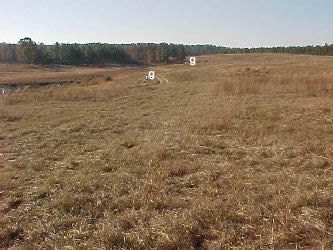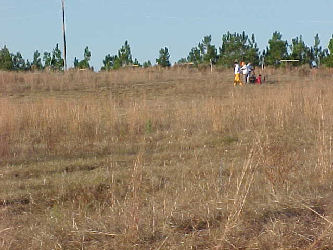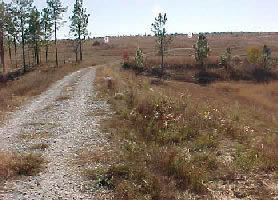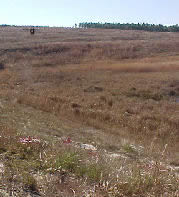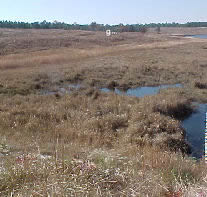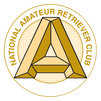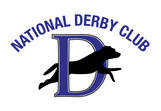Saturday, November 19, 2005 |
Once again a brisk morning greeted early participants. There had been a
killing frost overnight and vehicle windows required some heavy
scraping prior to leaving the motels. However it was clear, with little
wind and everyone found their way back to the Cooper Black Wildlife
area.
Test 9 was nearly ready as all arrived. It was in a field behind that of combined tests one and two and was a land triple with a long retired gun and a shot flyer on the right. The line faced a rolling grassy field that had mowed strips and a winding dirt road perpendicular to the line. A set of guns was located on the left,on the far edge of the road. They threw a dead drake back to the left. It landed on the lower slope of a gentle hill about 125 yards out. Quite far to the right and a bit deeper a set of flyer guns shot a rooster angled back to the left. It landed in the uncut strip on top of the slope,about 130+ yds. away. The third set was very deep in the field and fairly tight to the left mark. They threw a dead hen mallard to the left where it fell into cover along the slope of a swale. It was a good 250 yds. from line. The order was: Middle, left, right. There was an honor to the left of the running dog. When the dog was sent for the flyer, the middle station retired. It took about 5 minutes per dog
Test dogs were called to line at 6:50 a.m. Both hunted the middle bird a bit but did well over all. After they ran, judges moved the long mark blind closer to where the gunners stood to throw and camouflaged it well. At 7:22, the first running dog,#19 came to line.
The long mark fell along the slope of a swales. Early dogs had poor light but most recovered it with a hunt. Only one handled on it. The left mark could be deceiving as it was difficult to tell where it landed because of the back slope. The right, shot flyer excited dogs and that could dim the memory of the long, retired mark. Most dogs did well on the series, most hunting at least one of the marks. It progressed quickly and was completed at 8:50 a.m. when dog 72 returned to line. None had broken on the honor.
Test 10 was quickly organized in a distant field. Participants were asked to form a caravan and would be directed to the last site when ready. Callbacks were given and all were back as finalists!
In a few minutes the caravan traveled the short distance to number 10. As the caravan finished parking, the test dogs were called to line.
The tenth was a land/ water quad with three shot flyers and three retired guns. The line was on the far edge of a gravel, dike road. It faced a platter shaped depression beneath it. Beyond was a hill that rose sharply upward. The road curved to the right around the depression, at the base of the hill. A set of guns stood a short distance up the hill on the left.
Test dogs were called to line at 6:50 a.m. Both hunted the middle bird a bit but did well over all. After they ran, judges moved the long mark blind closer to where the gunners stood to throw and camouflaged it well. At 7:22, the first running dog,#19 came to line.
The long mark fell along the slope of a swales. Early dogs had poor light but most recovered it with a hunt. Only one handled on it. The left mark could be deceiving as it was difficult to tell where it landed because of the back slope. The right, shot flyer excited dogs and that could dim the memory of the long, retired mark. Most dogs did well on the series, most hunting at least one of the marks. It progressed quickly and was completed at 8:50 a.m. when dog 72 returned to line. None had broken on the honor.
Test 10 was quickly organized in a distant field. Participants were asked to form a caravan and would be directed to the last site when ready. Callbacks were given and all were back as finalists!
In a few minutes the caravan traveled the short distance to number 10. As the caravan finished parking, the test dogs were called to line.
The tenth was a land/ water quad with three shot flyers and three retired guns. The line was on the far edge of a gravel, dike road. It faced a platter shaped depression beneath it. Beyond was a hill that rose sharply upward. The road curved to the right around the depression, at the base of the hill. A set of guns stood a short distance up the hill on the left.
Test 10 - Land Quad
The threw a dead duck flat to the right where it fell in the grass about 110 yards away To their right and higher on the hill a second set shot a flying drake over a mowed strip, angled back to the left. It landed roughly 175 yards away. The third group was also to the right, but closer to line. They shot a flying rooster to the right, well ridden out at least 180+ yards away. Lastly, the fourth set was to the right of them and down the hill quite a way. They shot a drake flyer to the right that fell near a strip of higher cover about 200 yards out. The order was: Left middle flyer, left dead bird, right middle flyer, right flyer. As the dog was sent for the right flyer, the other three sets of guns retired.
Test dogs ran at 9:45 a.m. and demonstrated that the flooded depression beneath the dike was very tough going. Converging left marks and ridden out flyers also caused problems. When one wounded duck landed in the water, judges moved the right station farther up the hill.
At 10;40, the first running dog , #19 initiated the demanding series. It took about 7-8 MPD to complete.
As expected, the sheer number of flyers, distance, cover changes and configuration of the marks caused some dogs to become confused and lose concentration. In all, six of the 15 handled and sadly, one was picked up when it switched. At 1:15, all had run and the test was completed by dog # 41.
It was announced that the awards would be given in a field in front of the gallery. Preparations were made as all waited for the Judges to deliver their verdict. The decision came quickly and finalists were invited to the blue clothed table. Resting upon it were the spoils of success - a blue ribbon and silver bowls for the owner (s) and pro handler. After introducing all the finalists, Grayson Kelly announced the winner as FC AFC Clubmeads Road Warrior, the three year old owned by Frank Kashevarof and handled by Jim Gonia. Instantly applause, congratulations, photos and sheer joy followed. It had been a long and challenging week for all finalists. It would be a good ride home.
Test dogs ran at 9:45 a.m. and demonstrated that the flooded depression beneath the dike was very tough going. Converging left marks and ridden out flyers also caused problems. When one wounded duck landed in the water, judges moved the right station farther up the hill.
At 10;40, the first running dog , #19 initiated the demanding series. It took about 7-8 MPD to complete.
As expected, the sheer number of flyers, distance, cover changes and configuration of the marks caused some dogs to become confused and lose concentration. In all, six of the 15 handled and sadly, one was picked up when it switched. At 1:15, all had run and the test was completed by dog # 41.
It was announced that the awards would be given in a field in front of the gallery. Preparations were made as all waited for the Judges to deliver their verdict. The decision came quickly and finalists were invited to the blue clothed table. Resting upon it were the spoils of success - a blue ribbon and silver bowls for the owner (s) and pro handler. After introducing all the finalists, Grayson Kelly announced the winner as FC AFC Clubmeads Road Warrior, the three year old owned by Frank Kashevarof and handled by Jim Gonia. Instantly applause, congratulations, photos and sheer joy followed. It had been a long and challenging week for all finalists. It would be a good ride home.






